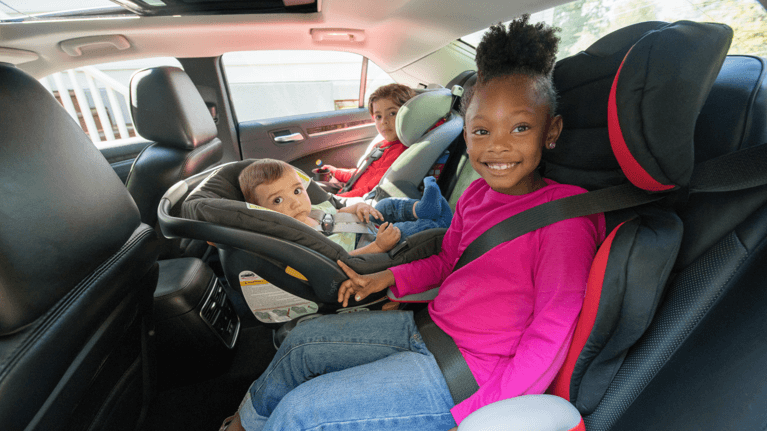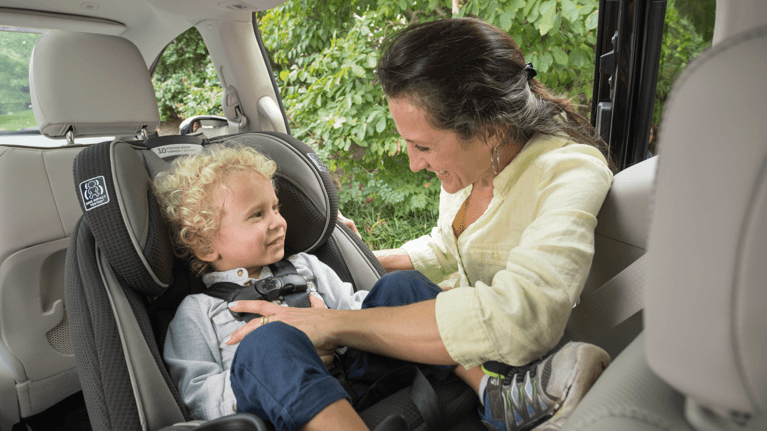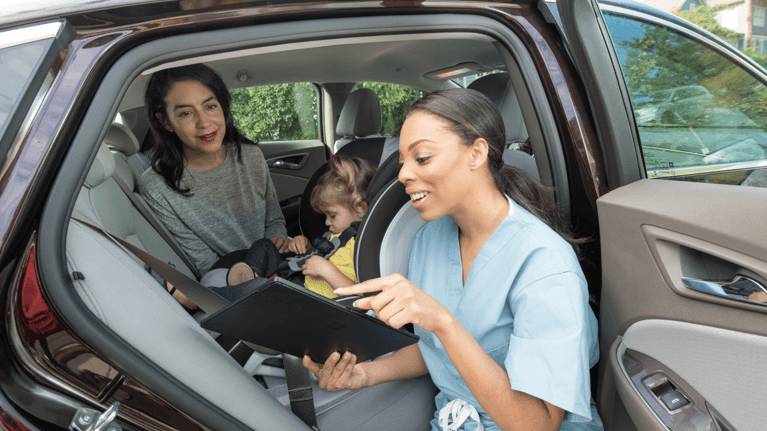When Can Babies Face Forward in a Car Seat?
Car seat safety experts answer all your questions about transitioning from rear-facing to forward-facing

Source: NHTSA
Whether you are a first-time parent or you notice your child's legs start to get uncomfortable, you might be wondering when babies can face forward in a car seat. The answer depends on the child, your location, and the car seat itself.
Still, it’s important to remember that all car seat safety experts recommend keeping your child in a rear-facing car seat for as long as possible. “When a child is rear-facing, the most fragile parts of their body—their head, neck, and spine, are fully supported by the car seat. In a collision, the car seat cradles the child, spreading the forces out evenly across the back of the car seat while supporting the child's body,” explains Chris Lumley, father of two and founder and CEO of Clek Inc., a proudly Canadian brand of award-winning infant car seats.
“Once a child is forward-facing, their body goes forward into the harness, and [it is now] bearing more of the collision forces.”
Here’s what you need to know about when to transition your baby from a rear-facing car seat to a forward-facing car seat.
When can babies face forward in a car seat?
Kelly Murphy, CPST-I and Cybex Safety Expert says there is no one-size-fits-all answer to when babies can face forward in a car seat. “Children under one should always ride in a rear-facing car seat. Requirements for car seats include minimum weights, heights, and ages for each mode, so check the labels and car seat instruction manual before moving a child to a new car seat or mode.”
Murphy also notes that individual states, provinces, and territory laws may also legislate when a child can face forward in a car seat. Remember that there's nothing wrong with moving a child to a forward-facing car seat when the minimum age, weight, and height requirements for that car seat are met. Ideally, though, a child should use a rear-facing car seat until reaching the maximum weight or height limit allowed by the car seat manufacturer.

How much do babies have to weigh to face forward?
Murphy tells me, that some car seats permit a child to ride forward-facing at the minimum weight of 20 pounds, but it may depend on what type of car seat you use. Alternatively, different states, provinces, and territories have their own laws regarding a child’s weight.
According to Joshua Dilts, Chicco Car Safety Product Manager and CPST, most infant-only car seats will fit babies until they are about a year old. “You must transition to a convertible or all-in-one car seat reaching at least 40 pounds rear-facing. You will want to use your car seat rear-facing until your child reaches either the rear-facing height or weight limit of their car seat, and then you can transition them to forward-facing as they grow older and stronger.”
What is the weight limit for a rear-facing car seat?
Dilts tells me that many children will outgrow a rear-facing seat in height before they reach the weight limit. If this is the case, it’s probably time to purchase a convertible seat. The weight limit for the rear-facing position varies by seat.
“Some rear-facing infant seats are outgrown at as little as 22 pounds, while other infant seats —such as the Cybex Cloud G Lux and Cybex Aton G/Aton G Swivel are outgrown at 35 pounds,” says Murphy. “Additionally, some larger types of rear-facing car seats (convertible, all-in-1, etc.) have limits that will permit children to ride rear-facing for two years or more and may not be outgrown until 40 pounds or even 50 pounds, the case of the Cybex Sirona S and Cybex Eternis S.”
So, if your child looks like they are outgrowing their car seat, it’s important to check the height and weight limits on what you have and start looking into buying a new one.
What is the safest place for a forward-facing car seat?
Lumley tells me that the center seating position is safest because it is furthest away from the door, should there be a side impact to the car.
However, this can be a moot point because the center position may not provide the most secure installation of your car seat. “So, I would say the safest place for a forward-facing car seat is the position that best allows for a proper secure installation, that has a top tether anchorage for that seating position, and that allows you to use extra safety features that may come with your seat for optimal safety performance,” he explains.
Murphy notes it’s crucial to use the top tether when installing your forward-facing car, whether with the seat belt or the vehicle's LATCH system, “The tether is an important safety feature. In the United States, we encourage the use of the tether. If you are in Canada, tether use is mandatory as part of Canadian law.”
Not sure where the tether is? Check the owner's manual of your car.

FAQs
What position should the harness be in when forward-facing?
“When forward-facing, the harness should be positioned at or slightly above the child’s shoulders, and the chest clip should be at armpit level,” says Murphy. “The child’s head can extend beyond the top of the headrest as long as the child’s ears are below the top of the headrest.”
What happens if you put a child in a forward-facing car seat too soon?
It’s very dangerous (and potentially against the law) to put a child in a forward-facing car seat before they are ready. “Children's vertebrae are less developed than an adult, and they carry as much as 25 percent of their body weight in their head, which puts them at a greater risk of injury if turned forward-facing too soon, so the longer you can keep a child rear-facing, the more protected they are,” says Lumley.
Why can’t a child just wear a seat belt?
While you might find it frustrating to constantly get your kid in and out of a car seat, putting them in the back or front seat with a seat belt isn’t the safest choice because seat belts aren’t designed to protect children. “Seat belts are made for adults and are a 3-point system. Using your child’s car seat to its maximum weight or height limit allows you to take advantage of the 5-point belt system as long as possible,” says Dilts.
Experts
Weekly Newsletter
Keep up with your baby's development, get the latest parenting content and receive special offers from our partners